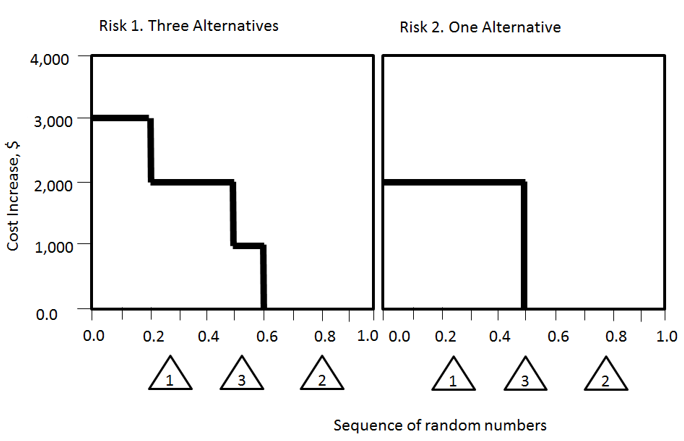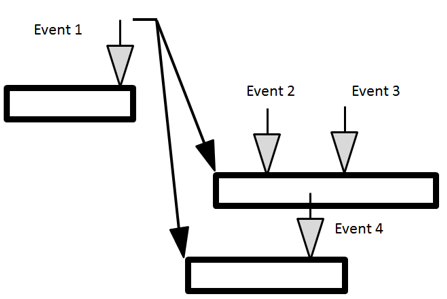In Event Chain Methodology event chains series of risk related to each other. These chains may significantly affect the course of the project by creating a ripple effect through the project. In this blog we will discuss how event chain are calculated as part of Monte Carlo schedule risk analysis. For more information about events and event chain please visit our previous blog.
How Event Chains are Calculated
The simplest way to define correlation between two risks is seeds. However, this works only when we need to ensure 100% correlation between risks. Each risk distribution has a seed and each risk has a statistical distribution. If the seed is the same for two risks, the risks will correlated. Due to linear congruence, all sequences of random numbers will be identical if seeds are the same. The figure below shows a sequence of random values for two risks with a cost impact. The first risk has three alternatives (20% chance of cost increase by $3,000, 30% of cost increase by $2000, and 10% chance of cost increase by $1000). The second risk has one alternative: 50% chance of cost increase of $2000. Both risks are correlated.
In the this table, we have an example of a risk correlation calculation of Monte Carlo simulations for the same example. Risk1 has 60% probability and Risk 2 has 50% probability. Star (*) any cost increase, and empty space means that cost increase is zero.
In case of 100% correlation Risk 2 occurs every time Risk 1 occurs, but Risk 1 can occur one more time because the probability of Risk 1 is higher than the probability of Risk 2.
When we use correlation coefficients or if there is a Sender/Receiver relationship between risks, Monte Carlo sampling needs to be performed to ensure predefined correlation conditions are accounted for.
Event Executing Other Activities and Event Driven Branching
One of the risk impact types is execution of activity and group of activities. But what if executed activity has risk events assigned to it as well? In this case it will be implicit event chain. Moreover, let’s assume that sender event has multiple alternatives. For example, event “Fire on the 67th floor during construction” may cause:
- Delay of 67th floor construction – 0.5% probability
- Execute new task: Repair of 67th floor – 0.5% probability
- Execute new task: Large Repair from 66th floor to 68 floor – 0.1% probability
Total probability of risk will be 2.5%. The effect, when risk alternatives cause execution of different activities or group of activities is called event driven branching . It is important to know that tasks “Repair of 67th floor” or “Large Repair from 66th floor to 68 floor” may also have other risks, for example “Budgetary Problems”.
Event Executing Other Activities and Event Driven Branching
Sometimes events can cause the start of an activity that has already been completed. This is a very common scenario: sometimes a previous activity must be repeated based on the results of a succeeding activity. Modeling of these scenarios using Event chain methodology is simple. The original project schedule does not need to be updated, as all that is required is to define the event and assign it to an activity that points to the previous activity. In addition, a limit to the number of times an activity can be repeated must be defined.
Delays in Event Chains
Events can cause other events to occur either immediately or with a delay. The delay is a property of the event subscription. The delay can be deterministic, but in most cases, it is probabilistic. If the time of the original event and the delay are known, it is possible to determine when the new event will happen and in some cases, the activity that will be associated with it. For example, original event “Relocation of the business” can cause event “Missing data” sometime after the original event.





